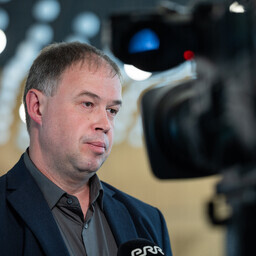PTA peadirektor Raimo Heinam ütleb, et SAK olukord on veel raske. "Kriitiline aeg on veel ees. Viis farmi on
suure riski all
," lisas ta. Praegu on riski all kolm farmi, kuna teistes farmides on peiteaeg läbi.
suure riski all
Tõlge fraasile: suure riski all
EN
at high risk
SAK on metsas endiselt ohtlik. Labori tulemused näitavad kolme-neli positiivset tulemust. "Foon ei ole metsas kadunud. Kõik farmid on
suure riski all
," ütles Heinam.
suure riski all
Tõlge fraasile: suure riski all
EN
at high risk
Sigade hukkamine on poole peal. "Meil on võimalik tööd teha veel 10-11 päeva," ütles PTA peadirektor. Kui uusi koldeid ei teki, lõpetatakse hukkamine umbes 25.-26. septembril.
Praegu kasutatakse sigade töötlemiseks Vireeni ja Atria võimekust. Heinam ütles, et Vireeni võimekus on suur, kuna sead on suured ja rasva on palju. Viimastel päevadel on saadetud Vireeni 90 kuni 100 tonni sigu. Varem arvati, et see võtab viis-neli nädalat, aga nüüd arvatakse, et kolm-neli nädalat.
Neljapäeval rääkisid PTA esindajad Metsküla matmispaiga läheduses elavate inimestega. Nad selgitasid hetke olukorda ja matmispaiga vajalikkust. Samuti räägiti uuringute tulemustest ja veekvaliteedist.
Iru katsetuses ei põlenud sead korralikult ära. Heinam ütles, et teisipäeval tehtud katsetuse tulemus oli negatiivne, aga katsetus oli vajalik. Enefit Greeni esindaja Siim Ots ütles, et Iru jäätmepõletusplokk on tehtud prügi põletamiseks, mitte hukatud sigade põletamiseks.
Katsetuses kasutati viite seakorjust, mis polnud SAK nakatunud. Heinam ütles, et
nakkuse levik
u korral on matmine ainus mõistlik lahendus. Praegu pole seda aga vaja teha.
nakkuse levik
Tõlge fraasile: nakkuse levik
EN
spread of infection
Heinam ütles, et kui olukord ei halvene, pole veel vaja matmisotsust langetada. Samas on Metsküla
matmispaik
parim koht, kui olukord halveneb. Piirkonnas on vee riskid väga väikesed, alla 0,1%. Geoloogia toetab matmispaiga kasutamist.
matmispaik
Tõlge fraasile: matmispaik
EN
burial site
Heinam rõhutas, et enamik Euroopa riike matab oma sead. Töötlemine või põletamine on haruldane. Metsküla külavanem Mehis Vinni ütles, et kohalikud mõistavad matmispaiga vajadust, aga sooviksid, et see oleks mujal.
Triin Kõrgmaa, põllumajandusministeeriumi toiduohutuse asekantsler, ütles, et
metssigade arvukuse vähendamine
on oluline SAK leviku piiramiseks. Valitsus toetab metssigade küttimise suurendamist.
metssigade arvukuse vähendamine
Tõlge fraasile: metssigade arvukuse vähendamine
EN
reduction of wild boar population
Metsseakonservide kokkuostu hankele laekus kolm pakkumist. Kokku ostetakse ligikaudu 5000 metsseast, mis teeb umbes 500 000 konservi. Kogumaksumus on 1,7 miljonit eurot. Riik hakkab pakkuma metssigadele
tasuta keeritsussi uuring
ut.
tasuta keeritsussi uuring
Tõlge fraasile: tasuta keeritsussi uuring
EN
free trichinellosis testing
PTA Director General Raimo Heinam says the ASF situation is still difficult. "The critical time is still ahead. Five farms are at high risk," he added. Currently, three farms are at risk because the latent period has ended in other farms.
ASF is still dangerous in the wild. Laboratory results show three to four positive results. "The background has not disappeared in the wild. All farms are at high risk," said Heinam.
The culling of pigs is halfway through. "We have the capacity to work for another 10-11 days," said the PTA Director General. If new outbreaks do not occur, culling will end around September 25-26.
Currently, the capacity of Vireen and Atria is used for processing pigs. Heinam said Vireen's capacity is high because the pigs are large and contain a lot of fat. In recent days, 90 to 100 tons of pigs have been sent to Vireen. Previously, it was thought this would take five-four weeks, but now it is estimated to take three-four weeks.
On Thursday, PTA representatives spoke with people living near the Metsküla burial site. They explained the current situation and the necessity of the burial site. The results of studies and water quality were also discussed.
In the Iru test, the pigs did not burn properly. Heinam said the result of the test conducted on Tuesday was negative, but the test was necessary. Enefit Green representative Siim Ots said the Iru waste incineration unit is designed to burn waste, not culled pigs.
The test used five pig carcasses that were not infected with ASF. Heinam said that in case of the spread of infection, burial is the only reasonable solution. However, there is no need to do so now.
Heinam said that if the situation does not worsen, there is no need to make a burial decision yet. At the same time, the Metsküla burial site is the best place if the situation worsens. The water risks in the area are very small, below 0.1%. Geology supports the use of the burial site.
Heinam emphasized that most European countries bury their pigs. Processing or burning is rare. Metsküla village elder Mehis Vinni said that locals understand the need for a burial site but would prefer it to be elsewhere.
Triin Kõrgmaa, Deputy Chancellor of Food Safety at the Ministry of Agriculture, said that reducing the wild boar population is essential to limit the spread of ASF. The government supports increasing the hunting of wild boar.
Three bids were received for the purchase of wild boar preserves. Approximately 5,000 wild boars will be purchased, making about 500,000 preserves. The total cost is 1.7 million euros. The state will offer free trichinosis testing for wild boars.

